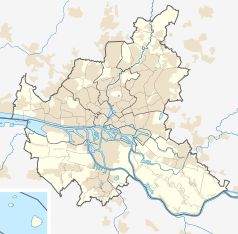Altona (Hamburg)
 | |||
| |||
| Państwo | |||
|---|---|---|---|
| Kraj związkowy | |||
| Powierzchnia | 77,4 km² | ||
| Populacja (31 grudnia 2011) • liczba ludności • gęstość | 261 213 3375 os./km² | ||
| Nr kierunkowy | 040 | ||
| Kod pocztowy | 20257 | ||
| Tablice rejestracyjne | HH | ||
| Strona internetowa | |||
| Portal | |||
Altona, Bezirk Altona – okręg administracyjny w zachodniej części Hamburga. Liczy 261 213 mieszkańców (31 grudnia 2011) i ma powierzchnię 77,4 km². Przez wiele stuleci była odrębnym miastem obok Hamburga, a przez pewien okres należała nawet do państwa duńskiego, a w XVII wieku należała również krótko do Szwecji.
Etymologia nazwy
Nazwa Altona według legendy wywodzi się stąd, że tutaj wokół pewnej gospody osiedlali się rzemieślnicy i rybacy, co dla Rady Miejskiej Hamburga było all to nah (niem. allzu nah – za blisko) granic miasta Hamburga.
Innym wyjaśnieniem nazwy miasta mogła być nazwa strumienia Altenau.
Podział administracyjny
W skład okręgu wchodzi 14 części miasta (Stadtteil):
- Altona-Altstadt
- Altona-Nord
- Bahrenfeld
- Blankenese
- Groß Flottbek
- Iserbrook
- Lurup
- Nienstedten
- Osdorf
- Othmarschen
- Ottensen
- Rissen
- Sternschanze
- Sülldorf
Historia
Od 1713 roku zarządcą (Oberpräsidentem) wówczas jeszcze oddzielnego miasta był Christian Ditlev Reventlow (1671–1738). Uczynił on z Altony kwitnący ośrodek handlu.
17 lipca 1932 r. doszło w Altonie do zamieszek między SA, a w większości komunistycznymi mieszkańcami Altony, w których zginęło 18 osób. Wydarzenia te które nazwano Altonaer Blutsonntag (Krwawa niedziela Altońska) przyczyniły się do zniesienia ostatniego demokratycznego rządu Prus i osłabienia przez to Republiki Weimarskiej.
1 kwietnia 1938 Altona została przyłączona przez władze nazistowskie do Hamburga na podstawie tzw. ustawy o Wielkim Hamburgu z 26 stycznia 1937. Na Altonie znajduje się stacja Hamburg-Altona, druga co do wielkości po Hamburg Hauptbahnhof stacja kolejowa w mieście.
Sport
- Altonaer FC von 1893 – klub piłkarski
Galeria
Pamiątka dawnego pułku Altona
Media użyte na tej stronie
Autor: NordNordWest, Licencja: CC BY-SA 3.0
Location map of Germany (Wp article: en:Germany)
Autor: Photo: Andreas Praefcke, Licencja: CC BY 3.0
Hamburg, Germany: Alleetheater (Hamburger Kammeroper) / Theater für Kinder, Max-Brauer-Allee, Altona
Autor: User:Wmeinhart, Licencja: CC BY-SA 3.0
Schiffsanleger Neumühlen an der Elbe mit Schiffen des Museumshafens, Hamburg 20.03.2005
Autor: Oryginalnym przesyłającym był Wahrerwattwurm z niemieckiej Wikipedii, Licencja: CC-BY-SA-3.0
Sol Lewitt, Black Form Dedicated to the Missing Jews, Altona Rathaus, Hamburg/ Germany.
Autor: MartinDieter, Licencja: CC-BY-SA-3.0
Station Hamburg-Altona (in the foreground: track 6).
Autor: NordNordWest, Licencja: CC BY-SA 3.0
Location map of Hamburg, Germany
(c) 1970gemini z niemieckiej Wikipedii, CC BY-SA 3.0
In the yard of the former garrison church to Altona, St. John's Church, on 5 October 1925, donated by the former 31er all 31ern memorial in the form of a 8.50 m high triangular monument of brick and ceramics at the sides watching in relief each man with sword and shield, was inaugurated. Each one of the men symbolizes the active, reserve and Landwehr Regiment of the 31.
Designed by the architects Heinrich Esselmann and Max Gerntke in cooperation with the sculptor August Henneberger the memorial was executed by John Kriegeris.
The inscription on the monument reads translated:
The fallen heroes to the grateful memory, the survivors as a warning, the coming generations to emulate.
It follows - as countless war memorials of the 19th and 20th century - the inscription (dedication) on the Prussian National Monument for the Liberation Wars on Kreuzberg hill in Berlin. It is also a quote from the speech of Paul von Hindenburg at the groundbreaking ceremony of the Tannenberg Memorial.
The parish of St. John worked in connection with a student project of the University of Hamburg, Design Department, is a redesign of the monument. Boards of the Altona artist Rainer Tiedje deny since the direct top view of the martial warrior figures. Destroyed a 2009 panel of the project was replaced by the artist Wiebke Logemann.
CDReventlow.























